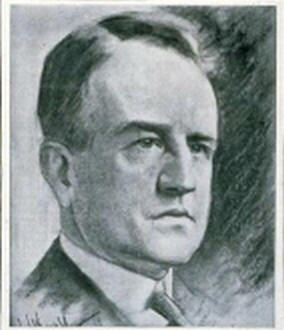|
Dwight Whitney Morrow

Born in Huntington, West Virginia. After graduating from Amherst College in
1895, he studied law at Columbia University and began practicing at the law
firm Simpson Thacher & Bartlett, in New York City. In 1903, he married
Elizabeth Cutter Morrow - Elizabeth Reeve Cutter, his college sweet heart.
In 1913, he partnered at J.P. Morgan & Co., the largest, most powerful
commercial bank in the United States in this era, financially backing
industrial giants such as General Motors Corporation - General Motors and
3M. As a partner at Morgan, he served as a Director on many corporate and
financial boards.
With the onset of World War I in Europe, the bank loaned United Kingdom -
Britain and France large sums of money, and purchased war materials in the
U.S. with it. When the United States joined the War, he became the director
of the National War Savings Committee for the State of New Jersey; served
abroad as advisor to the Allied Maritime Transport Council, as a member of
the Military Board of Allied Supply and as a civilian aide. With his proven
logistical and intellectual talents, he was moved to France and made chief
civilian aide to John J. Pershing - Gen. John J. Pershing.
In 1925, Morrow was called upon by his old Amherst College classmate,
President of the United States - President Calvin Coolidge to head the
Morrow Board. In September 1925, Coolidge ordered the court-martial of Col.
William L. Mitchell of the U.S. Army Air Service - Army Air Service for
"conduct prejudicial to good order and military discipline." Anticipating
adverse political reaction to the trial scheduled for November, and desirous
of shaping aviation policy to his own economic views, Coolidge asked Morrow
to take charge of a board of military, political, and civilian aviation
experts to inquire into all aspects of American aviation. The board's
report, published before Mitchell's conviction, recommended the creation of
an Air Corps within the Army equivalent to the U.S. Army Signal Corps -
Signal Corps or Quartermaster Corps, which resulted in the establishment of
the U.S. Army Air Corps in July 1926.
He was appointed United States Ambassador to Mexico by Coolidge from 1927 to
1930. He was widely hailed as a brilliant Ambassador, mixing popular appeal
with sound financial advice. In 1927, he invited famed aviator Charles A.
Lindbergh for a good will tour of Mexico. His daughter, Anne Morrow
Lindbergh - Anne Morrow, was introduced and soon engaged to Charles A.
Lindbergh. To thank the town of [[Cuernavaca]], where Morrow had a weekend
house, Morrow hired the Mexican Communist artist Diego Rivera to paint a
mural inside the Palacio de Cortés - Palace of Cortez.
He was elected as a Republican to the United States Senate to fill the
vacancy in the term ending March 3, 1931, caused by the resignation of
Walter Evans Edge, and at the same time was elected for the term commencing
March 4, 1931, and served from December 3, 1930, until his death in
Englewood, New Jersey, on October 5, 1931.
Trivia
*Morrow was a longtime summer resident of North Haven, Maine.
*His brother Jay Johnson Morrow - Jay J. Morrow was a governor of the
Panama Canal Zone.
*Dwight Morrow High School, in Englewood, New Jersey - Englewood,
New Jersey, is named in his honor.
*When Morrow was a senior at Amherst College, he was the only one to
vote for Calvin Coolidge for the title of "Most Likely to Succeed."
This Article was taken from
the Wikipedia free Encyclopedia.

|

